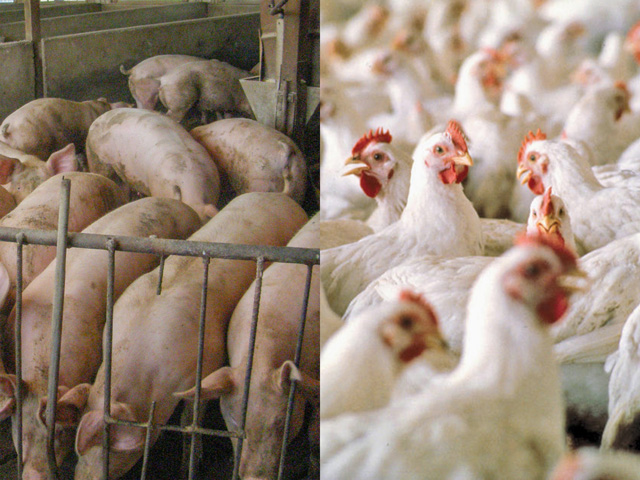Contract Aid Under CFAP 2
USDA Updates CFAP 2 Aid for Contract Growers
OMAHA (DTN) -- After criticism from U.S. senators, USDA on Tuesday updated its Coronavirus Food Assistance Program 2 (CFAP 2) aid payments to release $1 billion in aid to include contract producers for poultry and livestock, including swine producers.
USDA set an Oct. 12 deadline for producers to apply for CFAP 2 or modify existing aid applications.
The department is restarting enrollment for an aid program that had begun at the end of the Trump administration but was put on hold while the Biden administration re-examined the program.
USDA stated the appropriations bill provided up to $1 billion for payments to contract growers of livestock and poultry for lost revenue from Jan. 1, 2020, through Dec. 27, 2020. Contract growers eligible include those who raise "broilers, pullets, layers, chicken eggs, turkeys, hogs and pigs, ducks, geese, pheasants and quail may be eligible for assistance." USDA added updated aid includes eligible breeding stock and eggs for all eligible poultry types produced under contract.
Republican Sens Joni Ernst and Chuck Grassley from Iowa joined with Democratic Sens. Amy Klobuchar and Tina Smith from Minnesota to write Agriculture Secretary Tom Vilsack on Aug. 9 questioning what had happened to aid for contract swine growers. Congress had authorized the aid in the Consolidated Appropriations Act that passed last December. Former Agriculture Secretary Sonny Perdue had announced aid for swine producers under CFAP 1, just before leaving office. Those aid programs were then frozen and underwent a review by the Biden administration.
Senators from poultry states -- Sen. Chris Coons, D-Del., and Sen. Roger Wicker, R-Miss. -- also called on USDA to release aid under CFAP 2 to contract poultry producers.
P[L1] D[0x0] M[300x250] OOP[F] ADUNIT[] T[]
The American Farm Bureau Federation had raised concerns that farmers were being left out of early aid relief in 2020 and had sought to get aid for contract growers.
"We appreciate USDA recognizing the incredible losses farmers endured during the height of the pandemic," said Zippy Duvall, AFBF president. "When restaurants and schools closed, the demand for fresh food disappeared almost overnight. While previous CFAP funding addressed many losses, AFBF recognized that contract growers were left out and worked with lawmakers and the administration to ensure all farmers' voices were being heard."
Zach Ducheneaux, administrator for the Farm Service Agency, said the agency listened to feedback from stakeholders about gaps in pandemic assistance and made adjustments to make the program more equitable. USDA noted the department has provided roughly $7 billion in aid since the Biden administration began releasing funds under its Pandemic Assistance for Producers in March.
"The pandemic has had a tremendous impact on agricultural producers, and we have made significant progress since announcing our plans in March," Ducheneaux said
Ducheneaux said further announcements for pandemic aid will be announced "in the coming weeks" as USDA seeks to deal with issues in the food supply chain.
Payments for contract producers will be based a producer election to compare 2020 revenues with eligible revenue from either 2018 through Dec. 27, 2018, or 2019 through Dec. 27, 2019. USDA stated that change will provide more flexibility and make the program more equitable for contract farmers who had lower income in 2019 compared to a normal production year. The difference in revenue from 2020 to those prior years is then multiplied by 80% to determine a final payment. A producer who had generated $100,000 in income in 2018 -- and elected that year -- and saw 2020 income fall to $75,000, would show a $25,000 decline income. That $25,000 would be multiplied by .8 to generate a potential $20,000 payment.
USDA also is offering some flexibilities for operations that increased in size in 2020, or situations where a contract grower did not have full stretches of income in 2018 or 2019. There will also be assistance available to new contract growers who began their farming operations in 2020.
A caveat, however, is payments could end up being prorated, depending on the volume of eligible applications. USDA noted, "Payments to contract producers may be factored if total calculated payments exceed the available funding." Payments also will be made after the application period ends.
SPECIALTY CROPS
Along with the aid for contract livestock growers, USDA is changing its CFAP 2 calculations for "sales-based commodities," which are mainly specialty crops, or fruits, vegetables and nuts. Growers will also be given the options to substitute their 2018 sales figures for calculations for the lost potential market for 2020. Producers will be able to add to their income potential their 2018 crop insurance indemnities and disaster payments they received. Grass seed also has been added as an eligible crop for sales commodities under CFAP 2.
ENROLLMENT:
Sign up for CFAP 2 was reopened in March, but the deadline has now been set for Oct. 12. Producers can submit a CFAP 2 application or modify an existing one at their local Farm Service Agency office. For FSA office locations, go to https://www.farmers.gov/…
Chris Clayton can be reached at Chris.Clayton@dtn.com
Follow him on Twitter at @ChrisClaytonDTN
(c) Copyright 2021 DTN, LLC. All rights reserved.



